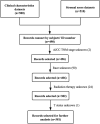Development and validation of a nomogram based on stromal score to predict progression-free survival of patients with papillary thyroid carcinoma
- PMID: 34240816
- PMCID: PMC8366082
- DOI: 10.1002/cam4.4112
Development and validation of a nomogram based on stromal score to predict progression-free survival of patients with papillary thyroid carcinoma
Abstract
Background: Growing evidence has proved that stromal cells, as the critical component of tumor microenvironment (TME), are closely associated with tumor's progression. However, the model based on stromal score to predict progression-free survival (PFS) in papillary thyroid carcinoma (PTC) has not been developed. The study aimed at exploring the relation between stromal score and prognosis, then establishing a nomogram to predict PFS of patients with PTC.
Method: We obtained the stromal score and clinicopathological characteristics of PTC patients from The Cancer Genome Atlas (TCGA) database. Cox regression analysis assisted in selecting prognosis-related factors. A stromal score-based nomogram was built and verified in the training and validation cohorts, respectively. The calibration curve, concordance index (C-index), decision curve analysis (DCA) as well as receiver operating characteristic (ROC) curve assisted in measuring the performance exhibited by the nomogram.
Results: We divided 381 PTC patients into the training cohort (n = 269) and the validation cohort (n = 112) randomly. Compared with patients who had a low stromal score, patients with a high stromal score appeared with significantly better PFS [Hazard ratio (HR) and 95% confidence interval (CI): 0.294, 0.130-0.664]. The C-index of the PFS nomogram was 0.764 (0.662-0.866) in the training cohort and 0.717 (0.603-0.831) in the validation cohort. The calibration curves for PFS prediction in the nomogram were remarkably consistent with the actual observation. DCA indicated superior performance of the nomogram to predict PFS than the American Joint Committee on Cancer (AJCC) Tumor Node Metastasis (TNM) staging system. The ROC curves showed the favorable sensitivity and specificity of the novel nomogram.
Conclusion: High stromal score was significantly associated with improved PFS in patients with PTC. The nomogram based on the stromal score and clinicopathological patterns yielded a reliable performance to predict the prognosis of PTC.
Keywords: nomogram; papillary thyroid carcinoma; progression-free survival; stromal score.
© 2021 The Authors. Cancer Medicine published by John Wiley & Sons Ltd.
Conflict of interest statement
The authors declare that they have no conflict of interest.
Figures







References
-
- Amin MB, Greene FL, Edge SB, et al. The Eighth Edition AJCC cancer staging manual: continuing to build a bridge from a population‐based to a more “personalized” approach to cancer staging. Cancer J Clin. 2017;67(2):93‐99. - PubMed
-
- Haugen BR, Alexander EK, Bible KC, et al. 2015 american thyroid association management guidelines for adult patients with thyroid nodules and differentiated thyroid cancer: the American Thyroid Association Guidelines Task Force on Thyroid Nodules and Differentiated Thyroid Cancer. Thyroid. 2016;26(1):1‐133. - PMC - PubMed
Publication types
MeSH terms
Grants and funding
LinkOut - more resources
Full Text Sources
Medical

